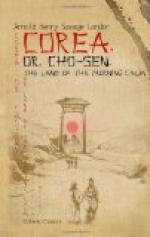The temple is crowded inside with rows of small images of all descriptions, some dressed in the long robes and winged hats of the officials, with dignified and placid expressions on their features; others, like fighting warriors, with fierce eyes and a ferocious look about them; but all covered with a good coating of dust and dirt, and all lending themselves as a sporting-ground to the industrious spider. The latter, disrespecting the high standing of these imperturbable deities, had stretched its webs across from nose to nose, and produced the appearance of a regular field of sporting operations, bestrewn with the spoils of its victims, which were lying dead and half eaten in the webs and on the floor.
The place goes by the name of the “Temple of the Five Hundred Images;” but I think that this number has been greatly exaggerated, though there certainly may be as many as two or three hundred.
The most interesting feature about this monastery is that at the back of the small building where the priests live is a long, narrow cavern in the rocks, with the ceiling blackened by smoke. This cavern is about a hundred feet in length, and at its further end is a pretty spring of delicious water. A little shrine, in the shape of an altar, with burning joss-sticks and a few lighted grease candles, stood near the spring, and there a priest was offering up prayers, beating a small gong the while he addressed the deities.
The descent from the temple was very steep and rough, over a path winding among huge boulders and rocks for nearly three miles. Then, reaching the plain, I accomplished the remainder of the distance to Seoul, over a fairly good road, and on almost level ground, all the way to the North Gate, by which I again entered the capital.
CHAPTER XXI
Corean physiognomy—Expressions of pleasure—Displeasure—Contempt—Fear
—Pluck—Laughter—Astonishmen
t—Admiration—Sulkiness—Jealousy
—Intelligence—Affection—Ima
gination—Dreams—Insanity—Its
principal causes—Leprosy—The family—Men and women—Fecundity—Natural
and artificial deformities—Abnormalities—Movements and attitudes—The
Corean hand—Conservatism.
The physiognomy of the Coreans is an interesting study, for, with the exception of the Chinese, I know of few nations who can control the movements of their features so well as do the Coreans. They are trained from their infancy to show neither pain, nor pleasure, grief nor excitement; so that a wonderful placidity is always depicted on their faces. None the less, however, though slightly, different expressions can be remarked. For instance, an attitude peculiar to them is to be noticed when they happen to ponder deeply on any subject; they then slightly frown, and with a sudden movement incline the head to the left, after previously drawing the head backwards. If in good humour or very pleased, again, though the expression is still grave and sedate, there is always a vivid sparkle to be detected in the generally sleepy eyes; and, curiously enough, while in our case the corners of the mouths generally curl up under such circumstances, theirs, on the contrary, are drawn downwards.




